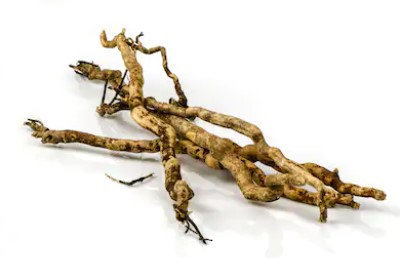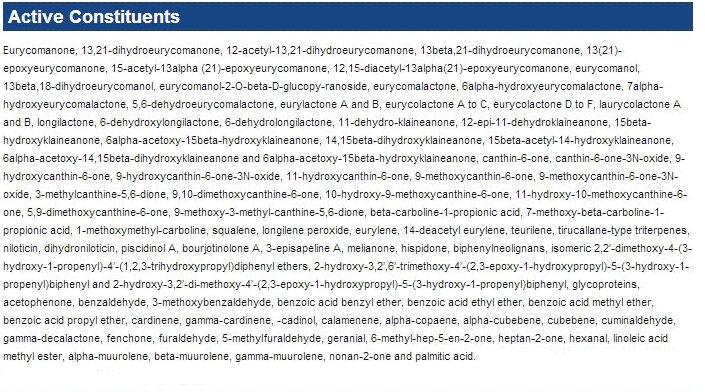Tongkat Ali Facts
All you need to know about Longjack / Tongkat Ali.
Below you will find info and answers to frequently asked questions about Tongkat Ali. You won't find any fake or unverified information, everything below can be verified and independant links are provided when possible.
Looking for the Buyers Guide?
This page is the Info guide, for the "Buyers Guide" which will show you what to look for and avoid, click HERE.
Once you have read the guides in full, you will hopefully have more knowledge and be ready to purchase.
What is Tongkat Ali?
Tongkat Ali is a rare plant found in Southeast Asia. The name translates to Ali's Stick or Wand due to the long twisty roots which resemble an antique walking stick or wizards wand, as seen below...

The plants botanical name is Eurycoma Longifolia Jack, which has led to it often being referred to as Long Jack or Longjack for short. Other less common names are Pasak Bumi, Tung Saw and Malaysian Ginseng.
Tongkat Ali can be found in Indonesia (Sumatra and Borneo) and Indochina (Malaysia, Vietnam, Laos, Myanmar and Thailand) and the Philippines.

What is Tongkat used for?
In Asia, the roots of the plant have many traditional uses, but in the West it's mainly sold as a supplement to maintain and support healthy free testosterone levels, which may lead to a healthy libido, more muscle mass etc. Sadly it is forbidden for european based sellers of herbal products to make health claims about them, therefore we cannot answer this question fully since any other benefits or use cases described may be mistaken as medicinal claims by some, even if they are not. You must do your own research.
Studies & research links.
https://scialert.net/fulltext/?doi=jas.2017.324.338
https://www.herbalgram.org/search?search=eurycoma
https://pubmed.ncbi.nlm.nih.gov/?term=eurycoma+longifolia+jack
What are the active constituents?
Below is an image taken from a scientific site showing the many known active constituents.

Is Tongkat a protected species?
Some people claim Tongkat is a protected species, however according to FRIM (Forest Research Institute of Malaysia), the plant can still be harvested in the wild legally, but there are now protected national parks and reserves containing Tongkat Ali in Malaysia to prevent extinction and harvesting from these areas only is forbidden. Raw roots can no longer be exported from Malaysia either, but the finished extract can. Some Malaysian manufacturers also import the roots from Indonesia. The above can be verified by contacting FRIM yourself, their site is https://www.frim.gov.my
Tongkat Ali and heavy metals
Many years ago in 1992, 100 Tongkat products from Malaysia were tested and 26% of these were found to contain high levels of mercury, because the roots were taken from forests close to built-up areas with high traffic and pollutants. This was years ago, did not affect the majority of manufacturers, and is no longer an issue as far as I am aware, but still, some sellers from Indonesia will say to avoid Malaysian extract because of this in an attempt to put people off rival products.
The report can be found at https://pubmed.ncbi.nlm.nih.gov/16567029/
PowerOfTheHerb.com sells an extract that uses Indonesian grown roots which are tested in the UK by independent 3rd party labs, but unlike other sellers we will not lie to you and say it is better than Malaysian extracts or that they are polluted, because the 2 countries produce extracts of equal quality, and of equally bad quality, depending on who you buy it from. Both countries have honest sellers and dishonest sellers.
Are there any plantations?
Yes, there are some field plantations, the oldest of which I know of mentioned is 7 years old at the time of writing this and is mentioned in a study HERE.

There are now even ways of growing Tongkat Ali to increase the active ingredients in the plant's roots, and even increase the number of shoots from 1, which is all a wild grown plant will have, to 6!
A study that you can download HERE mentions not only the above, but also that it is now possible to yield more Eurycomanone from a 1-year old cultivated plant than a mature wild plant, meaning in the future harvesting mature plants in to near extinction will no longer be needed, which is of course great news for the declining species and for manufacturers. It may even bring the price down if it ever happens on a large scale.
Don't believe dishonest manufacturers who say the root must be at least 10 years of age to be beneficial, it's just marketing. In this day and age with today's technology and extraction methods the age isn't really important, unless of course you are using very old and more traditional/simple methods of extraction, in which case it may or may not make a difference.
How many species of Tongkat / Longjack exist?
There are a total four species being referred by locals as Tongkat Ali according to the Journal of applied science. The species are...
Eurycoma longifolia Jack, also known as Long Jack, which is yellow/beige in color in its raw form and is the most studied and the most used for extracts. When people talk about Tongkat Ali, this is usually what they are referring to and is really the only species you should consider if you are basing your purchase on studies.

Polyathia bullata, also known as Hitam, which is Black/dark brown on the outside and creamy white on the inside, sometimes called King. Also used in extracts by some manufacturers though not as much as it is not very well studied.

Eurycoma apiculata, very little info about this species online.
Goniothalamus sp, very little info about this species available online.
Another plant called Jackiopsis ornata, also known as Merah, which has reddish pink tinge to it is often called Red Tongkat Ali by some people in Malaysia, although it is not actually a member of the same species and is unlikely to have the same benefits. It is said to have a pleasant Ginseng like taste.
What is a standardized / standardised Tongkat Ali extract?
A standardized extract, spelt with either an S or a Z depending on where you are from, is an extract that was created with set standards, usually to contain a specific percentage of an active constituent or constituents that have shown to be effective for whatever the herb is being sold for. In the case of Tongkat Ali, eurycomanone is the most common constituent for standardization as it is the most studied and looks to be one of the most beneficial.
Some manufacturers may also produce an extract using normal methods, and test every batch for the eurycomanone content after the extract has been created. If it meets or exceeds the percentage they require, it can be kept, If not then it cannot be used for that specific product and may be discarded, used in another product or modified until it does meet the requirements.
In Malaysia, it is said that all Tongkat Ali extract products should contain at least 0.8% Eurycomanone to be deemed effective, although this is a worst case scenario and ideally you want at least 2%. There are still plenty of fakes in circulation that contain none at all as it is not properly policed at this time.
World A.B.S' extract is Standardized using HPLC analyzation during the extraction phase and any extract that does not meet the 2.4% eurycomanone standard is adjusted accordingly.

A great article on the importance of standardization can be found here.
The only real downside to standardization is that to increase the percentage of one constituent others may need to be reduced, this may or may not decrease the desired effect depending on what you are trying to achieve. Since eurycomanone is one of the major and most studied of Tongkat Ali's constituents and the product sold here is standardised to 2.4% eurycomanone, this is not an issue as it it can still offer the full spectrum of active constituents.
Some companies claim 10% eurycomanone or higher, but then because of the costs needed to produce a 10% extract they will only put 100mg of that extract in the capsules, so you actually get less eurycomanone than you would in a lower percentage product that has 300-400mg in the capsules AND you get less of the other active constituents also, for example...
100mg at 8% is 8mg of eurycomanone and 92mg of the other constituents per capsule and a high price tag.
400mg at 2.4% is 9.6mg of Eurycomanone and 390.4mg of the other active constituents, with a lower price tag. This makes the 100mg 8% product more expensive and also inferior.
10% is incredibly rare for a herbal retailer to use, the majority of times it is a made up claim. The same applies to ratios above 1:50, with todays technology there is no reason to go that high, it's just a waste of a rare herb. On ebay you can find blindingly obviuos fake products such as 1:300 extract at under £9 per bottle. 1:300 does not exist, and real Tonglat Ali at under £9 a bottle does not exist. Sadly greed outweighs common sense in many people, and they have sold many bottles.
The problem with none-standardized extracts (extract ratios).
You may have seen extracts made using extract ratios from 20:1 all the way up to 1:200, or 200:1 as it is sometimes written, which in theory means 1 measly kilo of extract is produced from a whopping 200 kilos of raw root. This is a complete waste if true!
The problem with herbs made using only extract ratios is that it's impossible to know if the extract ratio given is real, since no tests exist to test for extract ratios, you would have to be in the room recording what went in and what came out to know that, leading to some manufacturers making them up to make their product sound better than it is.
You also have no way of knowing if the extract is even from the plant it claims to be from, unless it is tested and shown to contain active constituents only found in the plant, so many wil use a cheaper substitute herb such as Tribulus instead which looks and tastes very similar.
If you want more info about plant extracts and how they are made etc, there is plenty of information at www.ahpa.org about all sorts of things herbal, and an article explaining about extracts in more details can be found here.
The following link has lots of info on Eurycomanone...
http://www.ncbi.nlm.nih.gov/pubmed/?term=Eurycomanone
See more links about standardization below...
Future trends in standardization.
Standardization of herbal meds.
Standardization of herbals in the modern era.
What is the color of Tongkat Ali extract?

You will have no doubt heard some people say it should be dark brown and others light brown or tan/beige/yellow etc. The truth is that there is no color or shade that it "should" be and never has been or will be, the color may be determined by a number of factors such as temperatures used, exposure time to these temperatures, extraction methods, extract solvents used, extraction times, species used, drying methods etc. This applies to most herbs.
Tongkat Ali / Long Jack could be whitish-yellow, yellow, creamy white, pink, pinky brown, reddish brown, tan brown, dark brown etc, it honestly makes no difference whatsoever to the quality of the product.
Of course, you will find sellers of dark extracts saying it should be dark and sellers of light extracts saying it should be light, blah blah blah, etc etc. You can ignore every single one of them as none of them have any proof of what they say, it's simply dishonest marketinging technique, or sometimes lack of knowledge from resellers who just repeat what their supplier tells them.
Traditional extraction methods using high temps for long periods and milling tend to be darker, newer methods of extraction such as high-pressure extraction, and drying methods like freeze and spray drying, tend to produce lighter extracts as although the temperatures can be high they are only exposed to them for a fraction of the time, a few seconds instead of hours.
In fact, you can take a light extract, put it in an oven on a high temp and darken it up yourself to see what effect high temp extraction and drying methods would have. It will turn dark brown, proving temps affect the color. In fact, most things turn dark brown when exposed to high temps, right before they turn black and burn!
Below is what World A.B.S, who own the brand we sell, say about their extract...
Due to the process used to produce the new 2.4% eurycomanone HPLC Standardized Tongkat Ali extract, the color may vary from batch to batch. The color will range from a sandy brown to a slightly darker reddish brown. This variation arises from the color of the Tongkat Ali root used, the color of the chosen extract that passes the required specifications and also the drying process used.
 HPLC Standardized Extraction
One of the many benefits of using the HPLC standardized extract is that Tongkat Ali root can be sourced based on its sustainability, rather than color or age. World A.B.S allow the HPLC testing to monitor the strength of the extract during the liquid stage before going on to the drying phase.
 Freeze Drying Process
This technique drys the extract without overheating it, unlike the traditional drying process that often darkens the color.
 Traditional Drying Process
In traditional Tongkat Ali extraction, a vacuum drying process is commonly used. This longer exposure to higher temperatures will often overheat the extract damaging the active ingredients darkening the extract further, and in some instances reduce the extract almost to a charcoal state.
Other things of note regarding color...
I have had a few people recently emailing in asking about the color of Tongkat Ali extract, because they have read a few false statements on another brands site, which sells what is claimed to be 1:200 Tongkat in bigger capsules, that Tongkat Ali is "more impure the darker the color" This is obviously marketing hype which holds no truth whatsoever, and is very confusing for customers.
The statement they use is...
“Eurycomanone is snow white. The further from white an extract is the more impurities it contains.”
Yes, Eurycomanone "as a single constituent in its pure form when not attached to anything else" is White, BUT this is irrelevant and has nothing at all to do with regular herbal extracts in any way, shape or form, and is nothing at all to do with how pure or impure Tongkat Ali extract is. I will explain why in simple terms below...
Oranges are Orange, everyone knows this!
Pure Orange juice is Orange, everyone knows this!
Vitamin C, which is one of the many constituents in Oranges and the most well known, just like Eurycomanone is one of the many constituents in Tongkat Ali and the most well known, is white when removed and viewed in its pure form.
Everyone that has purchased Vitamin C powder knows this. Vitamin C powder is usually crystalline and white for those that don't know!
This obviously does not mean the further from White your Orange juice is, the less pure it is! Yet that is what the seller of the light extract does indeed state and seems to want you to believe, based on just one constituent being white, which is actually quite common. Removing solitary constituents from any herb or plant, regardless of what it is, almost always results in a color different to the plant or herb it came from, and that color is very often WHITE!
Tongkat Ali Diet, Dose and Side Effects
Visit the Diet & Dose page for known info on diet, dose, usage tips and side effects.
CLICK HERE TO ORDER



